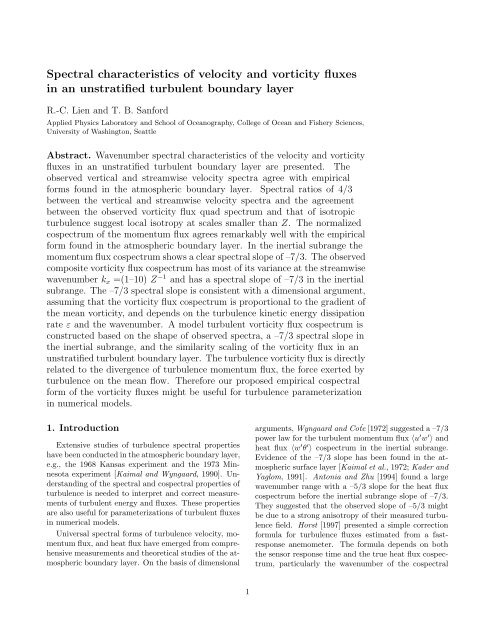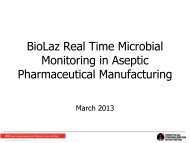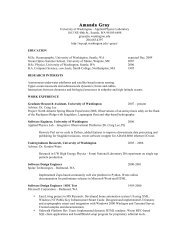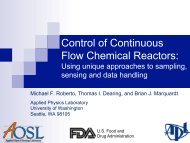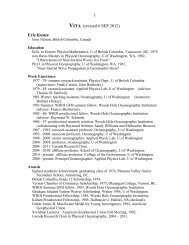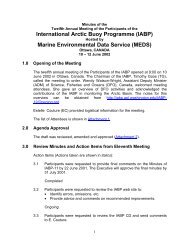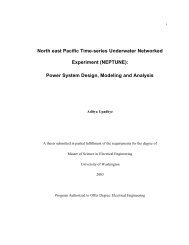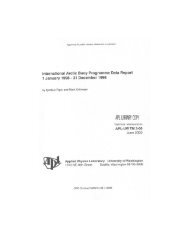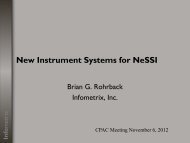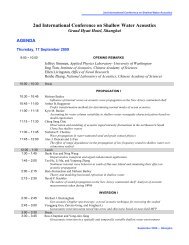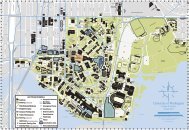Spectral characteristics of velocity and vorticity fluxes in an ...
Spectral characteristics of velocity and vorticity fluxes in an ...
Spectral characteristics of velocity and vorticity fluxes in an ...
Create successful ePaper yourself
Turn your PDF publications into a flip-book with our unique Google optimized e-Paper software.
<strong>Spectral</strong> <strong>characteristics</strong> <strong>of</strong> <strong>velocity</strong> <strong><strong>an</strong>d</strong> <strong>vorticity</strong> <strong>fluxes</strong><br />
<strong>in</strong> <strong>an</strong> unstratified turbulent boundary layer<br />
R.-C. Lien <strong><strong>an</strong>d</strong> T. B. S<strong>an</strong>ford<br />
Applied Physics Laboratory <strong><strong>an</strong>d</strong> School <strong>of</strong> Oce<strong>an</strong>ography, College <strong>of</strong> Oce<strong>an</strong> <strong><strong>an</strong>d</strong> Fishery Sciences,<br />
University <strong>of</strong> Wash<strong>in</strong>gton, Seattle<br />
Abstract. Wavenumber spectral <strong>characteristics</strong> <strong>of</strong> the <strong>velocity</strong> <strong><strong>an</strong>d</strong> <strong>vorticity</strong><br />
<strong>fluxes</strong> <strong>in</strong> <strong>an</strong> unstratified turbulent boundary layer are presented. The<br />
observed vertical <strong><strong>an</strong>d</strong> streamwise <strong>velocity</strong> spectra agree with empirical<br />
forms found <strong>in</strong> the atmospheric boundary layer. <strong>Spectral</strong> ratios <strong>of</strong> 4/3<br />
between the vertical <strong><strong>an</strong>d</strong> streamwise <strong>velocity</strong> spectra <strong><strong>an</strong>d</strong> the agreement<br />
between the observed <strong>vorticity</strong> flux quad spectrum <strong><strong>an</strong>d</strong> that <strong>of</strong> isotropic<br />
turbulence suggest local isotropy at scales smaller th<strong>an</strong> Z. The normalized<br />
cospectrum <strong>of</strong> the momentum flux agrees remarkably well with the empirical<br />
form found <strong>in</strong> the atmospheric boundary layer. In the <strong>in</strong>ertial subr<strong>an</strong>ge the<br />
momentum flux cospectrum shows a clear spectral slope <strong>of</strong> –7/3. The observed<br />
composite <strong>vorticity</strong> flux cospectrum has most <strong>of</strong> its vari<strong>an</strong>ce at the streamwise<br />
wavenumber k x =(1–10) Z −1 <strong><strong>an</strong>d</strong> has a spectral slope <strong>of</strong> –7/3 <strong>in</strong> the <strong>in</strong>ertial<br />
subr<strong>an</strong>ge. The –7/3 spectral slope is consistent with a dimensional argument,<br />
assum<strong>in</strong>g that the <strong>vorticity</strong> flux cospectrum is proportional to the gradient <strong>of</strong><br />
the me<strong>an</strong> <strong>vorticity</strong>, <strong><strong>an</strong>d</strong> depends on the turbulence k<strong>in</strong>etic energy dissipation<br />
rate ε <strong><strong>an</strong>d</strong> the wavenumber. A model turbulent <strong>vorticity</strong> flux cospectrum is<br />
constructed based on the shape <strong>of</strong> observed spectra, a –7/3 spectral slope <strong>in</strong><br />
the <strong>in</strong>ertial subr<strong>an</strong>ge, <strong><strong>an</strong>d</strong> the similarity scal<strong>in</strong>g <strong>of</strong> the <strong>vorticity</strong> flux <strong>in</strong> <strong>an</strong><br />
unstratified turbulent boundary layer. The turbulence <strong>vorticity</strong> flux is directly<br />
related to the divergence <strong>of</strong> turbulence momentum flux, the force exerted by<br />
turbulence on the me<strong>an</strong> flow. Therefore our proposed empirical cospectral<br />
form <strong>of</strong> the <strong>vorticity</strong> <strong>fluxes</strong> might be useful for turbulence parameterization<br />
<strong>in</strong> numerical models.<br />
1. Introduction<br />
Extensive studies <strong>of</strong> turbulence spectral properties<br />
have been conducted <strong>in</strong> the atmospheric boundary layer,<br />
e.g., the 1968 K<strong>an</strong>sas experiment <strong><strong>an</strong>d</strong> the 1973 M<strong>in</strong>nesota<br />
experiment [Kaimal <strong><strong>an</strong>d</strong> Wyngaard, 1990]. Underst<strong><strong>an</strong>d</strong><strong>in</strong>g<br />
<strong>of</strong> the spectral <strong><strong>an</strong>d</strong> cospectral properties <strong>of</strong><br />
turbulence is needed to <strong>in</strong>terpret <strong><strong>an</strong>d</strong> correct measurements<br />
<strong>of</strong> turbulent energy <strong><strong>an</strong>d</strong> <strong>fluxes</strong>. These properties<br />
are also useful for parameterizations <strong>of</strong> turbulent <strong>fluxes</strong><br />
<strong>in</strong> numerical models.<br />
Universal spectral forms <strong>of</strong> turbulence <strong>velocity</strong>, momentum<br />
flux, <strong><strong>an</strong>d</strong> heat flux have emerged from comprehensive<br />
measurements <strong><strong>an</strong>d</strong> theoretical studies <strong>of</strong> the atmospheric<br />
boundary layer. On the basis <strong>of</strong> dimensional<br />
arguments, Wyngaard <strong><strong>an</strong>d</strong> Co´te [1972] suggested a –7/3<br />
power law for the turbulent momentum flux 〈u ′ w ′ 〉 <strong><strong>an</strong>d</strong><br />
heat flux 〈w ′ θ ′ 〉 cospectrum <strong>in</strong> the <strong>in</strong>ertial subr<strong>an</strong>ge.<br />
Evidence <strong>of</strong> the –7/3 slope has been found <strong>in</strong> the atmospheric<br />
surface layer [Kaimal et al., 1972; Kader <strong><strong>an</strong>d</strong><br />
Yaglom, 1991]. Antonia <strong><strong>an</strong>d</strong> Zhu [1994] found a large<br />
wavenumber r<strong>an</strong>ge with a –5/3 slope for the heat flux<br />
cospectrum before the <strong>in</strong>ertial subr<strong>an</strong>ge slope <strong>of</strong> –7/3.<br />
They suggested that the observed slope <strong>of</strong> –5/3 might<br />
be due to a strong <strong>an</strong>isotropy <strong>of</strong> their measured turbulence<br />
field. Horst [1997] presented a simple correction<br />
formula for turbulence <strong>fluxes</strong> estimated from a fastresponse<br />
<strong>an</strong>emometer. The formula depends on both<br />
the sensor response time <strong><strong>an</strong>d</strong> the true heat flux cospectrum,<br />
particularly the wavenumber <strong>of</strong> the cospectral<br />
1
LIEN AND SANFORD: SPECTRA OF VELOCITY AND VORTICITY FLUXES 2<br />
peak. These formulas are needed to correct the observed<br />
flux cospectra so as to obta<strong>in</strong> correct estimates<br />
<strong>of</strong> <strong>fluxes</strong>.<br />
There have been relatively few studies <strong>of</strong> turbulence<br />
spectral properties <strong>in</strong> the oce<strong>an</strong>ic boundary layer compared<br />
to studies <strong>in</strong> the atmospheric boundary layer.<br />
Gross <strong><strong>an</strong>d</strong> Nowell [1985] found a slope <strong>of</strong> –5/3 <strong>of</strong> <strong>velocity</strong><br />
spectra <strong>in</strong> the <strong>in</strong>ertial subr<strong>an</strong>ge <strong>in</strong> <strong>an</strong> unstratified<br />
oce<strong>an</strong>ic tidal boundary layer. Their observed momentum<br />
flux cospectra have a signific<strong>an</strong>t fraction at wavelengths<br />
greater th<strong>an</strong> the dist<strong>an</strong>ce from the boundary,<br />
suggest<strong>in</strong>g that signific<strong>an</strong>t portion <strong>of</strong> turbulence stress<br />
might be due to flattened-out eddies. Bowden <strong><strong>an</strong>d</strong> Ferguson<br />
[1980] studied turbulence structure <strong>in</strong> the bottom<br />
boundary layer <strong>in</strong> the eastern Irish Sea. They also observed<br />
the -5/3 <strong>in</strong>ertial-subr<strong>an</strong>ge spectral slope at high<br />
wavenumbers. The ratio <strong>of</strong> streamwise <strong>velocity</strong> spectra<br />
to vertical <strong>velocity</strong> spectra approaches 3/4 at k x ≥ 2πZ,<br />
where k x is the streamwise wavenumber <strong><strong>an</strong>d</strong> Z is the<br />
height above the bottom, suggest<strong>in</strong>g isotropic turbulence.<br />
McPhee [1994] proposed that the turbulence mix<strong>in</strong>g<br />
length scale c<strong>an</strong> be estimated as the <strong>in</strong>verse <strong>of</strong> the<br />
wavenumber <strong>of</strong> the peak <strong>of</strong> vertical <strong>velocity</strong> spectrum.<br />
Their <strong>velocity</strong> spectra observed beneath multiyear pack<br />
ice <strong>in</strong> the western Weddell Sea agree with the empirical<br />
spectrum <strong>in</strong> the atmospheric boundary layer formulated<br />
by Busch <strong><strong>an</strong>d</strong> P<strong>an</strong><strong>of</strong>sky [1968].<br />
In the turbulent boundary layer the turbulent advective<br />
flux <strong>of</strong> <strong>vorticity</strong> plays <strong>an</strong> import<strong>an</strong>t dynamical role.<br />
Laboratory experiments <strong><strong>an</strong>d</strong> numerical simulations <strong>of</strong><br />
boundary layer turbulence have shown coherent vortical<br />
motions <strong>in</strong> turbulent boundary layers [Rob<strong>in</strong>son, 1991].<br />
These vortical motions are import<strong>an</strong>t for momentum<br />
tr<strong>an</strong>sfer between <strong>in</strong>ner <strong><strong>an</strong>d</strong> outer boundary layers [Kim<br />
et al., 1971; Willmarth <strong><strong>an</strong>d</strong> Lu, 1972; Blackwelder <strong><strong>an</strong>d</strong><br />
Eckelm<strong>an</strong>n, 1979; R<strong>an</strong>asoma <strong><strong>an</strong>d</strong> Sleath, 1992]. The<br />
sweep<strong>in</strong>g process <strong>of</strong> the momentum flux is related to<br />
the creation <strong>of</strong> new vortices at the boundary [Bernard<br />
et al., 1993].<br />
Indeed, there exists a k<strong>in</strong>ematic relation between the<br />
divergence <strong>of</strong> the momentum flux <strong><strong>an</strong>d</strong> the advective<br />
<strong>fluxes</strong> <strong>of</strong> <strong>vorticity</strong>. The divergence <strong>of</strong> the turbulence momentum<br />
flux represents the force that turbulence exerts<br />
on the me<strong>an</strong> flow. Therefore the turbulence <strong>vorticity</strong><br />
flux is directly related to the turbulence force on the<br />
me<strong>an</strong> flow. Klewicki et al. [1994] have conducted extensive<br />
studies <strong>of</strong> advective <strong>vorticity</strong> <strong>fluxes</strong>. They found<br />
that the divergence <strong>of</strong> the momentum flux is bal<strong>an</strong>ced<br />
by two components <strong>of</strong> the advective <strong>fluxes</strong> <strong>of</strong> <strong>vorticity</strong>,<br />
one associated with the gradient <strong>of</strong> <strong>vorticity</strong> <strong><strong>an</strong>d</strong> the<br />
other associated with the ch<strong>an</strong>ge <strong>of</strong> eddy scales from<br />
boundaries. This bal<strong>an</strong>ce is consistent with Tennekes<br />
<strong><strong>an</strong>d</strong> Lumley’s [1972] dimensional argument. The advective<br />
flux <strong>of</strong> <strong>vorticity</strong> is also import<strong>an</strong>t <strong>in</strong> the surface<br />
boundary layer, where the turbulence <strong>vorticity</strong> advected<br />
by Stokes drift is the ma<strong>in</strong> driv<strong>in</strong>g mech<strong>an</strong>ism <strong>of</strong> L<strong>an</strong>gmuir<br />
circulation [Li <strong><strong>an</strong>d</strong> Garrett, 1995].<br />
Recently, S<strong>an</strong>ford <strong><strong>an</strong>d</strong> Lien [1999] reported <strong>velocity</strong><br />
<strong><strong>an</strong>d</strong> <strong>vorticity</strong> measurements <strong>in</strong> <strong>an</strong> energetic tidal ch<strong>an</strong>nel<br />
<strong><strong>an</strong>d</strong> estimated the turbulent enstrophy, momentum<br />
flux, <strong><strong>an</strong>d</strong> advective <strong>vorticity</strong> flux. They proposed a new<br />
method to estimate the friction <strong>velocity</strong> based on the<br />
turbulence <strong>vorticity</strong> flux. Their sensor scale is 0.09 m.<br />
Wallace <strong><strong>an</strong>d</strong> Foss [1995] reviewed attenuation problems<br />
<strong>in</strong> <strong>vorticity</strong> measurements by numerous sensors <strong><strong>an</strong>d</strong> concluded<br />
that <strong>in</strong> order to have accurate measurements <strong>of</strong><br />
enstrophy, sensor scales must be <strong>of</strong> the order <strong>of</strong> the<br />
Kolmogorov scale. In oce<strong>an</strong>ic environments <strong><strong>an</strong>d</strong> tidal<br />
ch<strong>an</strong>nels this requires sensors on millimeter to centimeter<br />
scales.<br />
S<strong>an</strong>ford <strong><strong>an</strong>d</strong> Lien [1999] def<strong>in</strong>ed <strong>an</strong> eddy diffusivity <strong>of</strong><br />
<strong>vorticity</strong> A ζ based on the ratio <strong>of</strong> the advective <strong>vorticity</strong><br />
flux <strong><strong>an</strong>d</strong> the gradient <strong>of</strong> the me<strong>an</strong> <strong>vorticity</strong> <strong>in</strong> <strong>an</strong>alogy<br />
to the def<strong>in</strong>ition <strong>of</strong> eddy viscosity A ν . Because the estimate<br />
<strong>of</strong> A ζ is equal to A ν <strong>in</strong> the boundary layer, S<strong>an</strong>ford<br />
<strong><strong>an</strong>d</strong> Lien [1999] argued that both the momentum <strong><strong>an</strong>d</strong><br />
<strong>vorticity</strong> <strong>fluxes</strong> are not signific<strong>an</strong>tly attenuated by the<br />
f<strong>in</strong>ite sensor scale. To confirm this assertion, one needs<br />
to know the spectral forms <strong>of</strong> the momentum flux <strong><strong>an</strong>d</strong><br />
the <strong>vorticity</strong> flux.<br />
Here we present spectral properties <strong>of</strong> turbulence <strong>velocity</strong><br />
<strong><strong>an</strong>d</strong> <strong>vorticity</strong> <strong>fluxes</strong> observed <strong>in</strong> <strong>an</strong> oce<strong>an</strong>ic tidal<br />
boundary layer. We beg<strong>in</strong> with a brief review <strong>of</strong> classical<br />
theory <strong>of</strong> the turbulent <strong>velocity</strong> spectra <strong><strong>an</strong>d</strong> flux<br />
cospectra for isotropic turbulence <strong><strong>an</strong>d</strong> empirical <strong>velocity</strong><br />
spectra <strong><strong>an</strong>d</strong> flux cospectra observed <strong>in</strong> atmospheric<br />
boundary layers (section 2). In section 3, spectra <strong>of</strong><br />
the <strong>velocity</strong> <strong><strong>an</strong>d</strong> the momentum flux calculated from<br />
measurements <strong>in</strong> <strong>an</strong> unstratified tidal ch<strong>an</strong>nel are presented<br />
<strong><strong>an</strong>d</strong> compared with theoretical spectral forms<br />
<strong><strong>an</strong>d</strong> empirical forms found <strong>in</strong> the atmospheric boundary<br />
layer. Our observed <strong>vorticity</strong> flux spectrum is discussed<br />
<strong>in</strong> section 4. The spectral slope <strong>of</strong> the <strong>vorticity</strong><br />
flux cospectrum <strong>in</strong> the <strong>in</strong>ertial subr<strong>an</strong>ge is consistent<br />
with the prediction from the dimensional argument. An<br />
empirical model for the <strong>vorticity</strong> flux spectrum is proposed.<br />
In section 5 we discuss the quad spectrum <strong>of</strong> the<br />
<strong>vorticity</strong> <strong>fluxes</strong>, scal<strong>in</strong>g <strong>of</strong> the <strong>vorticity</strong> flux, <strong><strong>an</strong>d</strong> effect<br />
<strong>of</strong> viscous dissipation <strong><strong>an</strong>d</strong> summarize our results. Sensor<br />
response functions for the momentum <strong><strong>an</strong>d</strong> <strong>vorticity</strong><br />
<strong>fluxes</strong> are described <strong>in</strong> Appendix A. Fractions <strong>of</strong> resolved<br />
momentum <strong>fluxes</strong> <strong><strong>an</strong>d</strong> <strong>vorticity</strong> <strong>fluxes</strong> as a func-
LIEN AND SANFORD: SPECTRA OF VELOCITY AND VORTICITY FLUXES 3<br />
tion <strong>of</strong> wavenumber <strong><strong>an</strong>d</strong> dist<strong>an</strong>ce from the boundary are<br />
discussed <strong>in</strong> Appendix B.<br />
2. Review <strong>of</strong> Turbulence Velocity <strong><strong>an</strong>d</strong><br />
Flux Spectra<br />
2.1. Isotropic Turbulence<br />
For isotropic turbulence the <strong>velocity</strong> wavenumber<br />
spectra <strong><strong>an</strong>d</strong> the momentum flux cross spectra <strong>in</strong> the <strong>in</strong>ertial<br />
subr<strong>an</strong>ge are described by Batchelor [1959]. In the<br />
<strong>in</strong>ertial subr<strong>an</strong>ge the turbulence energy flux is const<strong>an</strong>t<br />
<strong><strong>an</strong>d</strong> spectral properties are <strong>in</strong>dependent <strong>of</strong> the external<br />
forc<strong>in</strong>g at large scales <strong><strong>an</strong>d</strong> viscous dissipation at Kolmogorov<br />
microscales. In this wavenumber r<strong>an</strong>ge, turbulence<br />
energy spectrum is well described by the Kolmogorov<br />
spectrum with a -5/3 spectral slope.<br />
The <strong>vorticity</strong> flux cross spectra <strong>in</strong> the <strong>in</strong>ertial subr<strong>an</strong>ge<br />
<strong>of</strong> isotropic turbulence c<strong>an</strong> be obta<strong>in</strong>ed based<br />
on Batchelor’s formula. In this <strong>an</strong>alysis we are <strong>in</strong>terested<br />
mostly <strong>in</strong> the streamwise wavenumber k x spectra.<br />
After Batchelor’s three-dimensional spectra are <strong>in</strong>tegrated<br />
over the vertical <strong><strong>an</strong>d</strong> sp<strong>an</strong>wise wavenumbers,<br />
the streamwise wavenumber spectra <strong>of</strong> the streamwise<br />
<strong>velocity</strong> Φ uu (k x ), the vertical <strong>velocity</strong> Φ ww (k x ), the momentum<br />
flux Φ uw (k x ), <strong><strong>an</strong>d</strong> the <strong>vorticity</strong> flux Φ wζy (k x )<br />
have the follow<strong>in</strong>g forms:<br />
Φ uu (k x ) = 18<br />
55 αε2/3 k −5/3<br />
x , (1)<br />
Φ ww (k x ) = 4 18<br />
3 55 αε2/3 kx −5/3 , (2)<br />
Φ uw (k x ) = 0, (3)<br />
Φ wζy (k x ) = −iα 3<br />
10 ε2/3 k −2/3<br />
x . (4)<br />
The Kolmogorov const<strong>an</strong>t α is ∼1.5 [Sreenivas<strong>an</strong>, 1995];<br />
ε is the turbulence k<strong>in</strong>etic energy dissipation rate; u <strong><strong>an</strong>d</strong><br />
w are the streamwise <strong>velocity</strong> <strong><strong>an</strong>d</strong> vertical <strong>velocity</strong> components,<br />
respectively; <strong><strong>an</strong>d</strong> ζ y is the sp<strong>an</strong>wise <strong>vorticity</strong>.<br />
For isotropic turbulence the streamwise wavenumber<br />
spectrum <strong>of</strong> vertical <strong>velocity</strong> is 4/3 <strong>of</strong> the streamwise<br />
<strong>velocity</strong> spectrum <strong>in</strong> the <strong>in</strong>ertial subr<strong>an</strong>ge. This has<br />
been used to test for local isotropy [McPhee <strong><strong>an</strong>d</strong> Smith,<br />
1976]. Another salient feature is the v<strong>an</strong>ish<strong>in</strong>g turbulence<br />
<strong>fluxes</strong>, because the isotropic turbulence has no<br />
preferred flux direction. Note that the nonzero quad<br />
spectrum <strong>of</strong> the <strong>vorticity</strong> flux (4) for isotropic turbulence<br />
does not <strong>in</strong>volve dynamic reasons but, rather, is<br />
a result <strong>of</strong> pure k<strong>in</strong>ematics. The reality condition <strong>of</strong><br />
the <strong>vorticity</strong> flux implies that Φ wζy (k x ) = Φ ∗ wζ y<br />
(−k x ),<br />
where the asterisk <strong>in</strong>dicates the complex conjugate.<br />
Therefore the quad spectrum <strong>in</strong> the positive streamwise<br />
wavenumber doma<strong>in</strong> equals the m<strong>in</strong>us <strong>of</strong> the quad<br />
spectrum <strong>in</strong> the negative streamwise wavenumber doma<strong>in</strong>,<br />
<strong><strong>an</strong>d</strong> the <strong>in</strong>tegration <strong>of</strong> quad spectrum over the<br />
whole streamwise wavenumber doma<strong>in</strong> v<strong>an</strong>ishes.<br />
2.2. Atmospheric Boundary Layer Observations<br />
The expressions for the spectra discussed <strong>in</strong> the previous<br />
section exclude effects <strong>of</strong> the boundary <strong><strong>an</strong>d</strong> stratification,<br />
which <strong>in</strong>troduce <strong>an</strong>isotropy <strong>in</strong>to the turbulence<br />
field. In the presence <strong>of</strong> a boundary <strong><strong>an</strong>d</strong> stratification,<br />
these spectral forms are modified. On the basis <strong>of</strong> data<br />
taken <strong>in</strong> the 1968 K<strong>an</strong>sas turbulent boundary layer experiment,<br />
Kaimal et al. [1972] obta<strong>in</strong>ed empirical spectral<br />
forms for turbulent <strong>velocity</strong> <strong><strong>an</strong>d</strong> momentum flux<br />
<strong>in</strong> different stability conditions. Under the neutral stability<br />
condition the streamwise <strong>velocity</strong> spectrum Φ uu ,<br />
the vertical <strong>velocity</strong> spectrum Φ ww , <strong><strong>an</strong>d</strong> the momentum<br />
flux cospectrum P uw are expressed as<br />
Φ uu (k x ) = 102 (<br />
2π u2 ∗Z 1 + 33 k ) −5/3<br />
xZ<br />
, (5)<br />
2π<br />
[<br />
Φ ww (k x ) = 2.1<br />
( ) ] 5/3 −1<br />
kx Z<br />
2π u2 ∗Z 1 + 5.3<br />
, (6)<br />
2π<br />
P uw (k x ) = − 12 (<br />
2π u2 ∗Z 1 + 9.6 ) −7/3<br />
2π k xZ , (7)<br />
where the factor <strong>of</strong> 2π is used to convert their expressions<br />
from cyclic wavenumber to radi<strong>an</strong> wavenumber<br />
<strong><strong>an</strong>d</strong> u ∗ is the friction <strong>velocity</strong>, u ∗ = (τ/ρ) 1/2 , where τ<br />
is the bottom stress <strong><strong>an</strong>d</strong> ρ is the density.<br />
The vertical velocities <strong>of</strong> turbulence are strongly affected<br />
by the boundary, so that most <strong>of</strong> their vari<strong>an</strong>ce<br />
is near the scale <strong>of</strong> the height above the bottom Z. The<br />
horizontal turbulent velocities are less affected by the<br />
presence <strong>of</strong> the boundary, <strong><strong>an</strong>d</strong> most <strong>of</strong> their vari<strong>an</strong>ce is<br />
at scales signific<strong>an</strong>tly greater th<strong>an</strong> Z.<br />
Turbulence <strong>velocity</strong> spectra observed <strong>in</strong> the atmospheric<br />
boundary layer have been found to be <strong>in</strong> good<br />
agreement with the spectra predicted by the empirical<br />
formulas <strong>of</strong> Kaimal et al. [1972] [Lee, 1996; Young,<br />
1987]. These empirical <strong>velocity</strong> spectra were also reproduced<br />
based on a theoretical argument <strong>of</strong> the turbulence
LIEN AND SANFORD: SPECTRA OF VELOCITY AND VORTICITY FLUXES 4<br />
energy budget which assumed that turbulence <strong>in</strong> the<br />
K<strong>an</strong>sas experiment was isotropic [Moraes <strong><strong>an</strong>d</strong> Goedert,<br />
1988].<br />
Turbulent momentum <strong>fluxes</strong> are carried mostly by<br />
large eddies. In the <strong>in</strong>ertial subr<strong>an</strong>ge, momentum flux<br />
cospectra P uw do not v<strong>an</strong>ish as required by the local<br />
isotropy condition (3) but, rather, decrease rapidly with<br />
a k −7/3 dependence [Wyngaard <strong><strong>an</strong>d</strong> Co´te, 1972]. The<br />
–7/3 spectral slope was predicted by the dimensional<br />
argument <strong>in</strong> which the cospectrum <strong>of</strong> momentum flux<br />
depends only on ε <strong><strong>an</strong>d</strong> k <strong><strong>an</strong>d</strong> is l<strong>in</strong>early proportional to<br />
the me<strong>an</strong> shear ∂ z U.<br />
Note that the <strong>in</strong>tegration <strong>of</strong> the momentum flux<br />
cospectrum over the entire wavenumber doma<strong>in</strong> should<br />
yield the total momentum flux, i.e., −u 2 ∗. The <strong>in</strong>tegration<br />
<strong>of</strong> the empirical momentum flux cospectrum proposed<br />
by Kaimal et al. [1972], however, yields a slightly<br />
underestimated momentum flux, 0.94 u 2 ∗.<br />
A similar empirical spectral form for the turbulent<br />
vertical <strong>velocity</strong> was proposed earlier by Busch <strong><strong>an</strong>d</strong><br />
P<strong>an</strong><strong>of</strong>sky [1968]; that is,<br />
Φ BP<br />
ww (k x ) = 0.54u 2 ∗Z<br />
[ ( ) ] 5/3 −1<br />
kx Z<br />
1 + 1.5<br />
. (8)<br />
2<br />
At low wavenumbers k x Z the spectral level <strong>of</strong> Busch<br />
<strong><strong>an</strong>d</strong> P<strong>an</strong><strong>of</strong>sky’s [1968] model is greater th<strong>an</strong> that <strong>of</strong><br />
Kaimal et al.’s [1972] model. McPhee [1994] found that<br />
his vertical <strong>velocity</strong> spectra taken <strong>in</strong> the oce<strong>an</strong> under the<br />
ice agree with Busch <strong><strong>an</strong>d</strong> P<strong>an</strong><strong>of</strong>sky’s empirical form.<br />
3. Observed Spectra<br />
3.1. Measurements, Experiment, <strong><strong>an</strong>d</strong> Data<br />
Selection<br />
The measurements discussed <strong>in</strong> this <strong>an</strong>alysis were<br />
taken with <strong>an</strong> electromagnetic <strong>vorticity</strong> meter (EMVM)<br />
[S<strong>an</strong>ford et al., 1999]. The sensor scale l is ∼0.09 m.<br />
The data were taken <strong>in</strong> Picker<strong>in</strong>g Passage, Wash<strong>in</strong>gton,<br />
<strong>in</strong> a strong ebb tide, ∼0.8 m s −1 peak surface<br />
tidal flow, dur<strong>in</strong>g October 23–26, 1995. Dur<strong>in</strong>g this<br />
experiment the flow was unstratified. Details <strong>of</strong> the<br />
experiment <strong><strong>an</strong>d</strong> measurements <strong><strong>an</strong>d</strong> a summary <strong>of</strong> the<br />
turbulence properties are given by S<strong>an</strong>ford <strong><strong>an</strong>d</strong> Lien<br />
[1999]. In this paper, spectra will be calculated us<strong>in</strong>g<br />
data taken when the EMVM was held at fixed depths to<br />
elim<strong>in</strong>ate possible contam<strong>in</strong>ation <strong>of</strong> the vertical <strong>velocity</strong><br />
by sensor motion <strong><strong>an</strong>d</strong> yield a cle<strong>an</strong> estimate <strong>of</strong> the<br />
streamwise wavenumber spectrum when us<strong>in</strong>g Taylor’s<br />
hypothesis to convert frequency to wavenumber. There<br />
are ∼150 m<strong>in</strong> <strong>of</strong> data taken at a 20-Hz sampl<strong>in</strong>g rate<br />
divided <strong>in</strong>to 79 time segments. Of these, 74 segments<br />
were taken with<strong>in</strong> 8 meters above the bottom (mab).<br />
Because the EMVM has two sensors on opposite sides<br />
<strong>of</strong> the <strong>in</strong>strument, 158 <strong>velocity</strong> spectra <strong><strong>an</strong>d</strong> flux cospectra<br />
are computed <strong>in</strong> this <strong>an</strong>alysis. The two sensors are<br />
separated by ∼0.25 m sp<strong>an</strong>wise. Therefore these two<br />
sensors observe the same eddies if the eddy scales are<br />
> 0.25 m.<br />
3.2. Velocity Spectra<br />
The streamwise <strong><strong>an</strong>d</strong> vertical <strong>velocity</strong> spectra are calculated<br />
us<strong>in</strong>g a multitaper spectral <strong>an</strong>alysis with two<br />
tapers [Percival <strong><strong>an</strong>d</strong> Walden, 1993]. The observed <strong>velocity</strong><br />
spectra are attenuated at small scales by the sensor<br />
response [S<strong>an</strong>ford et al., 1999]. To correct for the<br />
sensor effect, the observed <strong>velocity</strong> spectra have been<br />
compensated by divid<strong>in</strong>g by the sensor response functions.<br />
The observed <strong>velocity</strong> spectra are normalized by<br />
the measured turbulence k<strong>in</strong>etic energy dissipation rate<br />
ε <strong><strong>an</strong>d</strong> averaged <strong>in</strong> several depth b<strong>in</strong>s (Figure 1). This<br />
normalization (equations (1) <strong><strong>an</strong>d</strong> (2)) is done to collapse<br />
the spectra <strong>in</strong> the <strong>in</strong>ertial subr<strong>an</strong>ge for isotropic turbulence.<br />
The normalized streamwise <strong>velocity</strong> spectra are<br />
nearly <strong>in</strong>dependent <strong>of</strong> depth <strong><strong>an</strong>d</strong> show a spectral slope<br />
<strong>of</strong> –5/3. The normalized vertical <strong>velocity</strong> spectra are<br />
clearly dependent on Z. At scales greater th<strong>an</strong> Z, i.e.,<br />
k x Z ≪ 1, the vertical <strong>velocity</strong> spectra are nearly white.<br />
At scales smaller th<strong>an</strong> Z, i.e., k x Z ≫ 1, the vertical <strong>velocity</strong><br />
spectra exhibit a –5/3 <strong>in</strong>ertial-subr<strong>an</strong>ge spectral<br />
slope consistent with (2).<br />
Accord<strong>in</strong>g to the empirical spectral form observed<br />
<strong>in</strong> the atmospheric boundary layer (equations (5) <strong><strong>an</strong>d</strong><br />
(6)), <strong>velocity</strong> spectra normalized by Z should depend<br />
only on the nondimensional wavenumber k x Z <strong><strong>an</strong>d</strong> the<br />
friction <strong>velocity</strong> u ∗ . The friction <strong>velocity</strong> was calculated<br />
as 0.024 m s −1 by S<strong>an</strong>ford <strong><strong>an</strong>d</strong> Lien [1999]. Normalized<br />
wavenumber spectra at various depth b<strong>in</strong>s <strong>in</strong>deed<br />
collapse to a universal form (Figure 1b). The ratios between<br />
observed streamwise <strong><strong>an</strong>d</strong> vertical <strong>velocity</strong> spectra<br />
converge to the value <strong>of</strong> 3/4 expected for isotropic turbulence<br />
at k x Z ≥ 5 (Figure 1c). Saddoughi <strong><strong>an</strong>d</strong> Veeravalli<br />
[1994] tested the local isotropy <strong>in</strong> the turbulent<br />
boundary layer at high Reynolds numbers <strong>in</strong> a w<strong>in</strong>d<br />
tunnel <strong><strong>an</strong>d</strong> found that the energy spectra reached the<br />
local isotropy at k x ε 1/2 S −3/2 ≈ 3. If we assume that<br />
ε = u 3 ∗κ −1 Z −1 <strong><strong>an</strong>d</strong> that the me<strong>an</strong> shear S = u ∗ κ −1 Z −1<br />
<strong>in</strong> the <strong>in</strong>ertial sublayer, the energy spectra should exhibit<br />
a local isotropy condition at k x Z ≥ 7.5, close to<br />
our observed r<strong>an</strong>ge <strong>of</strong> k x Z ≥ 5.<br />
The composites <strong>of</strong> normalized spectra <strong>of</strong> the observed
LIEN AND SANFORD: SPECTRA OF VELOCITY AND VORTICITY FLUXES 5<br />
vertical <strong><strong>an</strong>d</strong> streamwise <strong>velocity</strong> are compared with empirical<br />
spectra suggested by Kaimal et al. [1972] <strong><strong>an</strong>d</strong><br />
Busch <strong><strong>an</strong>d</strong> P<strong>an</strong><strong>of</strong>sky [1968] (Figure 2). Because the momentum<br />
flux 〈u ′ w ′ 〉 is nearly const<strong>an</strong>t <strong>in</strong> the bottom 9<br />
m [S<strong>an</strong>ford <strong><strong>an</strong>d</strong> Lien, 1999], only spectra at Z < 9 m<br />
are used for construct<strong>in</strong>g the composite spectra. The<br />
streamwise spectrum agrees with the empirical form <strong>of</strong><br />
Kaimal et al. [1972] with<strong>in</strong> the 95% confidence <strong>in</strong>terval,<br />
except at the highest wavenumbers, where the observed<br />
spectrum falls below the empirical spectrum. The discrep<strong>an</strong>cy<br />
at high wavenumbers might be due to sensor<br />
attenuation. Although the sensor effect has been corrected<br />
by the response function, it is possible that the<br />
correction was not adequate ow<strong>in</strong>g to the smear<strong>in</strong>g effect<br />
<strong>of</strong> the vary<strong>in</strong>g me<strong>an</strong> streamwise <strong>velocity</strong>. Our composite<br />
vertical <strong>velocity</strong> spectrum agrees with the empirical<br />
form suggested by Busch <strong><strong>an</strong>d</strong> P<strong>an</strong><strong>of</strong>sky [1968] with<strong>in</strong><br />
the confidence <strong>in</strong>terval, similar to McPhee’s [1994] results.<br />
At low wavenumbers the observed spectrum is<br />
slightly greater th<strong>an</strong> the empirical spectrum found by<br />
Kaimal et al. [1972] <strong>in</strong> the atmospheric boundary layer.<br />
3.3. Momentum Flux Cospectra<br />
We compute the momentum flux cospectra from observations,<br />
normalize them by Z, <strong><strong>an</strong>d</strong> form a composite<br />
cospectrum as a function <strong>of</strong> the normalized wavenumber<br />
k x Z (Figure 3). Aga<strong>in</strong>, only spectra calculated at Z <<br />
9 m are used to construct the composite spectrum. The<br />
observed composite momentum flux cospectrum agrees,<br />
with<strong>in</strong> a 95% confidence <strong>in</strong>terval, with the empirical<br />
spectrum [Kaimal et al., 1972] based on the estimated<br />
friction <strong>velocity</strong> <strong>of</strong> 0.024 m s −1 [S<strong>an</strong>ford <strong><strong>an</strong>d</strong> Lien, 1999].<br />
At small scales, i.e., k x Z ≥ 20, the observed cospectrum<br />
falls below the empirical cospectrum, although<br />
they still agree with each other with<strong>in</strong> the confidence<br />
<strong>in</strong>tervals. The sensor response attenuates the observed<br />
cospectra at small scales. The sensor response function<br />
for the momentum flux cospectrum <strong>of</strong> the EMVM measurements<br />
is derived <strong>in</strong> Appendix A. We correct the<br />
observed spectra by the sensor response function <strong><strong>an</strong>d</strong><br />
recalculate the composite momentum flux cospectrum.<br />
The corrected momentum flux cospectrum is slightly<br />
greater th<strong>an</strong> the uncorrected cospectra at large k x Z,<br />
but the difference is <strong>in</strong>signific<strong>an</strong>t. In other words, our<br />
estimates <strong>of</strong> the momentum flux are not signific<strong>an</strong>tly affected<br />
by the f<strong>in</strong>ite size <strong>of</strong> the EMVM sensor <strong>in</strong> the high-<br />
Reynolds-number flow <strong>of</strong> <strong>an</strong> unstratified tidal ch<strong>an</strong>nel.<br />
Indeed, on the basis <strong>of</strong> the empirical momentum flux<br />
cospectrum <strong><strong>an</strong>d</strong> the EMVM response function, we conclude<br />
that the EMVM estimates capture more th<strong>an</strong> 94%<br />
<strong>of</strong> the total momentum flux at 0.5 mab (Appendix B).<br />
Φ u Z −1 & Φ w Z −1 (m 2 s −2 )<br />
10 −2<br />
10 −3<br />
10 −4<br />
10 −5<br />
10 −6<br />
10 −7<br />
Φ u (ε¯ / ε) 2/3 (m 3 s −2 )<br />
10 −2 15.9 m<br />
(a)<br />
10 −3<br />
10 −4<br />
10 −5<br />
k x Z<br />
5.3 m<br />
1.9 m<br />
0.5 m<br />
10 −1 10 0 10 1 10 2<br />
10 −1 10 0 10 1<br />
(b)<br />
k x (m −1 )<br />
Φ u / Φ w<br />
10 1 (c)<br />
10 0<br />
10 −1<br />
10 −1 10 0 10 1 10 2<br />
k x Z<br />
Figure 1. (a) Observed spectra <strong>of</strong> streamwise <strong>velocity</strong><br />
(solid curves) <strong><strong>an</strong>d</strong> vertical <strong>velocity</strong> (dashed curves)<br />
averaged <strong>in</strong> various depth b<strong>in</strong>s as a function <strong>of</strong> streamwise<br />
wavenumber k x . The labels <strong>in</strong>dicate the height<br />
above the bottom Z <strong>of</strong> each depth b<strong>in</strong>. The shad<strong>in</strong>g<br />
represents the 95% confidence <strong>in</strong>terval. These spectra<br />
have been normalized by the observed turbulence<br />
k<strong>in</strong>etic energy dissipation rate ε. (b) Observed spectra<br />
<strong><strong>an</strong>d</strong> wavenumbers normalized by Z (us<strong>in</strong>g equations<br />
(5) <strong><strong>an</strong>d</strong> (6)). The horizontal <strong><strong>an</strong>d</strong> vertical <strong>velocity</strong> spectra<br />
are collapsed to their correspond<strong>in</strong>g universal forms.<br />
The thick solid <strong><strong>an</strong>d</strong> dashed curves represent the me<strong>an</strong><br />
normalized streamwise <strong><strong>an</strong>d</strong> vertical <strong>velocity</strong> spectra, respectively.<br />
(c) Ratios between observed streamwise <strong>velocity</strong><br />
spectra <strong><strong>an</strong>d</strong> vertical <strong>velocity</strong> spectra. Dots are<br />
ratios <strong>of</strong> spectra at different depth b<strong>in</strong>s. Crosses are<br />
ratios <strong>of</strong> me<strong>an</strong> spectra. Vertical bars across symbols<br />
denote the 95% confidence <strong>in</strong>terval <strong>of</strong> the F test. The<br />
horizontal l<strong>in</strong>e <strong>in</strong> Figure 1c <strong>in</strong>dicates the 3/4 value expected<br />
for isotropic turbulence (equations (1) <strong><strong>an</strong>d</strong> (2)).
LIEN AND SANFORD: SPECTRA OF VELOCITY AND VORTICITY FLUXES 6<br />
Fractions <strong>of</strong> the resolved momentum flux as a function<br />
<strong>of</strong> wavenumber are discussed <strong>in</strong> Appendix B to provide<br />
other experimentalists with references for <strong>in</strong>terpret<strong>in</strong>g<br />
their observations.<br />
Φ u / (u *<br />
2<br />
Z) & Φ w / (u *<br />
2<br />
Z)<br />
10 0<br />
10 −1<br />
10 −2<br />
10 −3<br />
10 −4<br />
10 −1 10 0 10 1 10 2<br />
10 1<br />
Figure 2. Comparison <strong>of</strong> the observed streamwise <strong>velocity</strong><br />
spectrum <strong><strong>an</strong>d</strong> vertical <strong>velocity</strong> spectrum with empirical<br />
spectra found <strong>in</strong> the atmosphere boundary layer.<br />
The thick solid curve is the composite observed streamwise<br />
<strong>velocity</strong> spectrum. The th<strong>in</strong> solid curve is the<br />
empirical streamwise <strong>velocity</strong> spectrum suggested by<br />
Kaimal et al. [1972]. The thick dashed curve is the<br />
composite observed vertical <strong>velocity</strong> spectrum, <strong><strong>an</strong>d</strong> the<br />
th<strong>in</strong> dashed curve is Kaimal et al.’s [1972] empirical vertical<br />
<strong>velocity</strong> spectrum. The th<strong>in</strong> solid curve with open<br />
circles is the empirical vertical <strong>velocity</strong> spectrum proposed<br />
by Busch <strong><strong>an</strong>d</strong> P<strong>an</strong><strong>of</strong>sky [1968]. Shad<strong>in</strong>gs denote<br />
the 95% confidence <strong>in</strong>terval <strong>of</strong>the observed spectra.<br />
−P uw / (u *<br />
2 Z)<br />
10 0<br />
10 −1<br />
10 −2<br />
10 −3<br />
10 −4<br />
−7/3<br />
(a)<br />
10 −5<br />
10 −1 10 0 10 1 k x Z<br />
10 2<br />
−k x Z P uw / (u *<br />
2 Z)<br />
0.3<br />
0.25<br />
0.2<br />
0.15<br />
0.1<br />
0.05<br />
(b)<br />
0<br />
10 −1 10 0 10 1 k x Z<br />
10 2<br />
Figure 3. Comparison <strong>of</strong> the observed momentum flux<br />
cospectrum with the empirical cospectral form found<br />
by Kaimal et al. [1972] <strong>in</strong> the atmospheric boundary<br />
layer. (a) Comparison <strong>of</strong> observed <strong><strong>an</strong>d</strong> model spectra.<br />
(b) Vari<strong>an</strong>ce-preserv<strong>in</strong>g form <strong>of</strong> Figure 3a. The thick<br />
solid curves are observed spectra. The th<strong>in</strong> solid curves<br />
are the empirical spectra suggested by Kaimal et al.<br />
[1972]. The thick dashed curves, which are nearly overlapped<br />
by the thick solid curves, are observed spectra<br />
corrected for the sensor response function. In the <strong>in</strong>ertial<br />
subr<strong>an</strong>ge the empirical momentum flux cospectrum<br />
has a spectral slope <strong>of</strong> –7/3.<br />
Saddoughi <strong><strong>an</strong>d</strong> Veeravalli [1994] found that the momentum<br />
flux cospectrum dropped to zero, <strong>an</strong> <strong>in</strong>dication<br />
<strong>of</strong> local isotropy, at k x Z ≥ 25. The fall<strong>of</strong>f <strong>of</strong> our observed<br />
spectrum from the model spectrum at k x Z ≥ 20<br />
could also be because k x Z ≥ 20 is <strong>in</strong> the wavenumber<br />
r<strong>an</strong>ge where the viscous dissipation becomes import<strong>an</strong>t.<br />
4. Vorticity Flux Spectrum<br />
4.1. Observed Vorticity Flux Cospectrum<br />
The observed <strong>vorticity</strong> flux cospectra averaged <strong>in</strong><br />
three depth b<strong>in</strong>s are shown <strong>in</strong> Figure 4 as a vari<strong>an</strong>cepreserv<strong>in</strong>g<br />
plot. Most <strong>of</strong> the <strong>vorticity</strong> flux is at wavenumbers<br />
<strong>of</strong> 0.2–5 m −1 . In this wavenumber r<strong>an</strong>ge the <strong>vorticity</strong><br />
flux is mostly positive. Below <strong><strong>an</strong>d</strong> beyond this<br />
r<strong>an</strong>ge the <strong>vorticity</strong> flux cospectra are sometimes less<br />
th<strong>an</strong> zero. Because <strong>of</strong> their large error bars, the <strong>vorticity</strong><br />
flux cospectra <strong>in</strong> these three depth b<strong>in</strong>s are not<br />
signific<strong>an</strong>tly different, except that the <strong>vorticity</strong> flux <strong>in</strong><br />
the depth b<strong>in</strong> 4–8 m seems to be slightly larger at k x <strong>of</strong><br />
0.4–0.5 m −1 . S<strong>an</strong>ford <strong><strong>an</strong>d</strong> Lien [1999] observed a simi-
LIEN AND SANFORD: SPECTRA OF VELOCITY AND VORTICITY FLUXES 7<br />
lar feature <strong>in</strong> a vertical pr<strong>of</strong>ile <strong>of</strong> <strong>vorticity</strong> flux that was<br />
calculated from data taken while the EMVM was vertically<br />
pr<strong>of</strong>iled. The averaged <strong>vorticity</strong> flux <strong>in</strong> the depth<br />
r<strong>an</strong>ge 0–2 m is slightly greater th<strong>an</strong> that <strong>in</strong> the 2–4 m<br />
depth b<strong>in</strong> but not signific<strong>an</strong>tly so relative to the statistical<br />
confidence <strong>in</strong>terval. The variation <strong>of</strong> the estimated<br />
<strong>vorticity</strong> flux with<strong>in</strong> each depth b<strong>in</strong> is greater th<strong>an</strong> the<br />
variation among different depth b<strong>in</strong>s.<br />
To our knowledge, no empirical spectral form has<br />
been suggested for the <strong>vorticity</strong> flux <strong>in</strong> the atmospheric<br />
or oce<strong>an</strong>ic turbulent boundary layer. Despite the great<br />
variability <strong>of</strong> the observed <strong>vorticity</strong> flux cospectra, they<br />
do have a common spectral shape, i.e., large <strong><strong>an</strong>d</strong> positive<br />
at <strong>in</strong>termediate wavenumbers <strong><strong>an</strong>d</strong> smaller <strong><strong>an</strong>d</strong><br />
sometimes negative at small <strong><strong>an</strong>d</strong> large wavenumbers.<br />
This commonly observed shape suggests the existence<br />
<strong>of</strong> a universal spectral form.<br />
Follow<strong>in</strong>g the dimensional <strong>an</strong>alysis used by Wyngaard<br />
<strong><strong>an</strong>d</strong> Coté [1972] for deriv<strong>in</strong>g the momentum flux<br />
<strong><strong>an</strong>d</strong> heat flux cospectra <strong>in</strong> the <strong>in</strong>ertial subr<strong>an</strong>ge, we assume<br />
that the <strong>vorticity</strong> flux cospectrum <strong>in</strong> the <strong>in</strong>ertial<br />
subr<strong>an</strong>ge depends on only three parameters: ε, k, <strong><strong>an</strong>d</strong><br />
the vertical gradient <strong>of</strong> me<strong>an</strong> sp<strong>an</strong>wise <strong>vorticity</strong> ∂ z 〈ζ y 〉.<br />
We further assume that the cospectrum is l<strong>in</strong>early proportional<br />
to the gradient <strong>of</strong> the me<strong>an</strong> <strong>vorticity</strong> but with<br />
<strong>an</strong> opposite sign, consistent with the concept <strong>of</strong> a downgradient<br />
flux. The dimensional <strong>an</strong>alysis yields a form<br />
for the <strong>vorticity</strong> flux cospectrum <strong>of</strong><br />
k x P wζy (m s −2 )<br />
3.5 x 10−4<br />
3<br />
2.5<br />
2<br />
1.5<br />
1<br />
0.5<br />
0<br />
−0.5<br />
5.3 m<br />
2.8 m<br />
1.1 m<br />
10 0 10 1<br />
k x (m −1 )<br />
Figure 4. Observed <strong>vorticity</strong> flux cospectra averaged<br />
<strong>in</strong> three depth b<strong>in</strong>s: 0–2 m (solid curve), 2–4 m (dashed<br />
curve), <strong><strong>an</strong>d</strong> 4–8 m (dotted curve). The shad<strong>in</strong>g denotes<br />
the 95% confidence <strong>in</strong>terval calculated from the<br />
bootstrap method. Labels <strong>in</strong>dicate the averaged heights<br />
above the bottom <strong>of</strong> the three depth b<strong>in</strong>s.<br />
4.2. Model Vorticity Flux Cospectrum<br />
P wζy (k x ) ∝ −ε 1/3 ∂ z 〈ζ y 〉k −7/3<br />
x ∝ u 2 ∗(k x Z) −7/3 . (9)<br />
This expression is similar to the empirical forms for the<br />
momentum <strong><strong>an</strong>d</strong> heat flux cospectra. In the <strong>in</strong>ertial sublayer,<br />
ε = u 3 ∗κ −1 Z −1 <strong><strong>an</strong>d</strong> ∂ z 〈ζ y 〉 ≈ −u ∗ κ −1 Z −2 . These<br />
identities have been used <strong>in</strong> (9). The <strong>vorticity</strong> flux<br />
cospectrum does not v<strong>an</strong>ish <strong>in</strong> the <strong>in</strong>ertial subr<strong>an</strong>ge,<br />
but it decays rapidly with a spectral slope <strong>of</strong> –7/3.<br />
In the turbulent boundary layer, large eddies are affected<br />
by the presence <strong>of</strong> the boundary. Follow<strong>in</strong>g the<br />
empirical momentum flux cospectral form [Kaimal et<br />
al., 1972], we propose that the <strong>vorticity</strong> cospectrum has<br />
the form<br />
P model<br />
wζ y<br />
(k x ) = au 2 ∗ [1 + b(k x Z)] −r . (10)<br />
This form is consistent with our observed <strong>vorticity</strong> spectra;<br />
that is, most <strong>of</strong> the vari<strong>an</strong>ce is <strong>in</strong> the <strong>in</strong>termediate<br />
wavenumbers <strong><strong>an</strong>d</strong> decays at lower <strong><strong>an</strong>d</strong> higher wavenumbers.<br />
The dimensional argument <strong>in</strong> (9) suggests that<br />
the spectral slope <strong>in</strong> the <strong>in</strong>ertial subr<strong>an</strong>ge r = 7/3. Parameters<br />
a <strong><strong>an</strong>d</strong> b depend on the magnitude <strong>of</strong> the <strong>vorticity</strong><br />
flux <strong><strong>an</strong>d</strong> the wavenumber <strong>of</strong> the dom<strong>in</strong><strong>an</strong>t <strong>vorticity</strong><br />
flux, respectively; that is,<br />
〈w ′ ζ ′ y〉 =<br />
∫ ∞<br />
0<br />
dk x Pwζ model a<br />
y<br />
(k x ) =<br />
b(r − 1) u2 ∗/Z, (11)<br />
(k x Z) peak = (r − 1) −1 b −1 , (12)<br />
where (k x Z) peak is the wavenumber <strong>of</strong> the maximum<br />
<strong>vorticity</strong> flux vari<strong>an</strong>ce k x P model<br />
wζ y<br />
.<br />
An averaged normalized <strong>vorticity</strong> flux cospectrum <strong>in</strong><br />
normalized wavenumber b<strong>in</strong>s k x Z is shown <strong>in</strong> Figure 5.<br />
This spectrum is constructed by first normaliz<strong>in</strong>g each<br />
<strong>of</strong> the total 148 <strong>vorticity</strong> flux cospectra by u 2 ∗ <strong><strong>an</strong>d</strong> the<br />
correspond<strong>in</strong>g wavenumbers by Z −1 <strong><strong>an</strong>d</strong> then averag<strong>in</strong>g<br />
all the 148 normalized cospectra <strong>in</strong> the normalized
LIEN AND SANFORD: SPECTRA OF VELOCITY AND VORTICITY FLUXES 8<br />
wavenumber b<strong>in</strong>s. Note that ∼80% <strong>of</strong> spectra are observed<br />
<strong>in</strong> the bottom 4 m. The averaged, normalized<br />
<strong>vorticity</strong> flux cospectrum shows a wavenumber-b<strong><strong>an</strong>d</strong>limited<br />
spectral shape similar to that <strong>of</strong> the momentum<br />
flux cospectrum. At small, normalized wavenumbers<br />
the lower bounds <strong>of</strong> the <strong>vorticity</strong> flux estimates<br />
are negative <strong><strong>an</strong>d</strong> show large error bars. The vari<strong>an</strong>cepreserv<strong>in</strong>g<br />
plot k x ZP wζy u −2<br />
∗ shows a peak at k x Z ≈ 2.<br />
The correspond<strong>in</strong>g estimate <strong>of</strong> b is 3/8 based on (12).<br />
P wζy / u *<br />
2<br />
(a)<br />
10 −2<br />
10 −3<br />
−7/3<br />
10 −4<br />
10 −1 10 0 10 1<br />
k x Z<br />
10 2<br />
10 −1<br />
k x Z P wζy /u *<br />
2<br />
0.4<br />
0.35<br />
0.3<br />
0.25<br />
0.2<br />
0.15<br />
0.1<br />
0.05<br />
(b)<br />
10 −1 10 0 10 1 10 2<br />
k x Z<br />
Figure 5. (a) Comparison <strong>of</strong> the observed <strong>vorticity</strong><br />
flux cospectrum with our proposed model <strong>vorticity</strong> flux<br />
cospectrum. (b) The vari<strong>an</strong>ce-preserv<strong>in</strong>g form <strong>of</strong> Figure<br />
5a. The thick solid curve is the observed <strong>vorticity</strong><br />
flux cospectrum calculated us<strong>in</strong>g spectra obta<strong>in</strong>ed <strong>in</strong><br />
the bottom 8 m, <strong><strong>an</strong>d</strong> the th<strong>in</strong> curve is the model spectrum<br />
(equation (13)). The thick dashed curve is the<br />
observed <strong>vorticity</strong> flux cospectrum corrected for the sensor<br />
response function. A spectral slope <strong>of</strong> –7/3 is shown<br />
for comparison with the model spectrum <strong>in</strong> the <strong>in</strong>ertial<br />
subr<strong>an</strong>ge. Open circles represent observed <strong>vorticity</strong> flux<br />
cospectra averaged us<strong>in</strong>g data <strong>in</strong> the bottom 5 m, where<br />
the observed <strong>vorticity</strong> flux follows the similarity scal<strong>in</strong>g<br />
(Figure 7).<br />
In high-Reynolds-number flows one might expect the<br />
mix<strong>in</strong>g coefficients <strong>of</strong> momentum <strong><strong>an</strong>d</strong> <strong>vorticity</strong> to have<br />
a similar magnitude. Indeed, S<strong>an</strong>ford <strong><strong>an</strong>d</strong> Lien [1999]<br />
found that the magnitudes <strong>of</strong> the estimated eddy diffusivity<br />
<strong>of</strong> <strong>vorticity</strong> [A ζ = −〈w ′ ζ y〉(∂ ′ z 〈ζ y 〉) −1 ] <strong><strong>an</strong>d</strong> the<br />
eddy viscosity <strong>of</strong> momentum [A ν = −〈u ′ w ′ 〉(∂ z U) −1 ]<br />
were similar with<strong>in</strong> 6 mab.<br />
In the energetic tidal boundary layer the primary<br />
contribution to the me<strong>an</strong> sp<strong>an</strong>wise <strong>vorticity</strong> is the vertical<br />
shear <strong>of</strong> streamwise <strong>velocity</strong>; that is, ζ y = ∂ z U<br />
[S<strong>an</strong>ford <strong><strong>an</strong>d</strong> Lien, 1999]. In the <strong>in</strong>ertial sublayer the<br />
eddy viscosity <strong>of</strong> momentum A ν <strong><strong>an</strong>d</strong> the eddy diffusivity<br />
<strong>of</strong> <strong>vorticity</strong> A ζ c<strong>an</strong> be approximated as u ∗ κZ,<br />
<strong><strong>an</strong>d</strong> the vertical gradient <strong>of</strong> the me<strong>an</strong> sp<strong>an</strong>wise <strong>vorticity</strong><br />
∂ z 〈ζ y 〉 = −u ∗ κ −1 Z −2 . Therefore the turbulent <strong>vorticity</strong><br />
flux <strong>in</strong> the <strong>in</strong>ertial sublayer c<strong>an</strong> be expressed as<br />
〈w ′ ζ y〉 ′ = −A ζ ∂ z 〈ζ y 〉 = u 2 ∗Z −1 .<br />
Tennekes <strong><strong>an</strong>d</strong> Lumley [1972] similarly scaled the <strong>vorticity</strong><br />
flux 〈w ′ ζ y〉 ′ as ul∂ z 〈ζ y 〉, where u = u ∗ is the<br />
turbulent <strong>velocity</strong> scale <strong><strong>an</strong>d</strong> l = κZ is the turbulent<br />
length scale <strong>in</strong> the boundary layer. Therefore the scal<strong>in</strong>g<br />
<strong>of</strong> 〈w ′ ζ y〉 ′ = u 2 ∗Z −1 is also suggested by Tennekes<br />
<strong><strong>an</strong>d</strong> Lumley [1972].<br />
If we accept the forego<strong>in</strong>g scal<strong>in</strong>g argument for the<br />
turbulent <strong>vorticity</strong> flux, (11) c<strong>an</strong> be expressed as a/[b(r−<br />
1)] = 1. Given r = 7/3 <strong><strong>an</strong>d</strong> b = 3/8, the estimate <strong>of</strong><br />
a is 1/2. Therefore we have constructed the follow<strong>in</strong>g<br />
form for the model <strong>vorticity</strong> flux cospectrum:<br />
P model<br />
wζ y<br />
(k x ) = 1/2u 2 ∗ [1 + 3/8(k x Z)] −7/3 . (13)<br />
The model spectrum has the shape <strong>of</strong> observed spectra,<br />
the slope <strong>of</strong> –7/3 <strong>in</strong> the <strong>in</strong>ertial subr<strong>an</strong>ge predicted by<br />
the dimensional <strong>an</strong>alysis, <strong><strong>an</strong>d</strong> the dom<strong>in</strong><strong>an</strong>t peak displayed<br />
by the observed spectra, <strong><strong>an</strong>d</strong> the magnitude <strong>of</strong><br />
the <strong>vorticity</strong> flux is consistent with flows <strong>in</strong> the <strong>in</strong>ertial<br />
sublayer.<br />
Note that when construct<strong>in</strong>g the model spectrum,<br />
we have used only one property <strong>of</strong> the observed spectrum,<br />
the wavenumber <strong>of</strong> the maximum <strong>vorticity</strong> flux<br />
vari<strong>an</strong>ce. We did not force the level <strong><strong>an</strong>d</strong> shape <strong>of</strong> the<br />
model spectrum to agree with those <strong>of</strong> the observed<br />
spectrum. Surpris<strong>in</strong>gly, the model spectrum clearly reproduces<br />
the observed <strong>vorticity</strong> flux cospectrum (Figure<br />
5) <strong>in</strong> the wavenumber r<strong>an</strong>ge from the peak <strong>of</strong> the <strong>vorticity</strong><br />
flux vari<strong>an</strong>ce extend<strong>in</strong>g more th<strong>an</strong> 1 decade <strong>in</strong>to<br />
the <strong>in</strong>ertial subr<strong>an</strong>ge where a spectral slope <strong>of</strong> –7/3 exists.<br />
At low wavenumbers, k x Z ≤ 0.9, the observed<br />
<strong>vorticity</strong> flux spectrum drops much more rapidly th<strong>an</strong><br />
the proposed model spectrum.<br />
Although the <strong>vorticity</strong> flux cospectrum <strong><strong>an</strong>d</strong> the momentum<br />
flux cospectrum have a very similar spectral<br />
shape, the wavenumber <strong>of</strong> the maximum flux is higher<br />
for the <strong>vorticity</strong> flux th<strong>an</strong> for the momentum flux. This<br />
is partially because most <strong>of</strong> the turbulent momentum<br />
is at large scales <strong><strong>an</strong>d</strong> the vari<strong>an</strong>ce <strong>of</strong> <strong>vorticity</strong> is mostly<br />
contributed by smaller-scale eddies.<br />
To correct for the f<strong>in</strong>ite-size-sensor effect, we modify<br />
the observed <strong>vorticity</strong> flux cospectra by their response<br />
functions (Appendix A) <strong><strong>an</strong>d</strong> form the composite spectrum.<br />
The corrected cospectrum is not signific<strong>an</strong>tly different<br />
from the uncorrected one, except at k x Z ≥ 40,<br />
where the corrected spectrum shows a small bump. We<br />
suspect that this small bump is unreal <strong><strong>an</strong>d</strong> is caused<br />
by divid<strong>in</strong>g the observed spectrum by a response func-
LIEN AND SANFORD: SPECTRA OF VELOCITY AND VORTICITY FLUXES 9<br />
tion that is small. On the basis <strong>of</strong> the EMVM response<br />
function for the <strong>vorticity</strong> flux cospectrum (Appendix A)<br />
<strong><strong>an</strong>d</strong> our model spectrum, the EMVM resolves > 90% <strong>of</strong><br />
the total <strong>vorticity</strong> flux at Z > 1 m (Appendix B).<br />
5. Discussion <strong><strong>an</strong>d</strong> Summary<br />
5.1. Vorticity Flux Quad Spectrum <strong>of</strong> Isotropic<br />
Turbulence<br />
Note that the <strong>vorticity</strong> flux quad spectrum Q wζy<br />
<strong>of</strong> the isotropic turbulence does not v<strong>an</strong>ish [Batchelor,<br />
1959]. We calculate the composite quad spectrum <strong>of</strong><br />
the measured <strong>vorticity</strong> flux, correct for the sensor response<br />
function, <strong><strong>an</strong>d</strong> compare the result with the expected<br />
quad spectrum <strong>in</strong> the <strong>in</strong>ertial subr<strong>an</strong>ge, as predicted<br />
by (4) (Figure 6). The response function <strong>of</strong> the<br />
quad spectrum is based on the theoretical quad-spectral<br />
form <strong>of</strong> Batchelor [1959] for isotropic turbulence. The<br />
observed <strong>vorticity</strong> flux quad spectrum shows a peak<br />
near k x Z = 2, similar to its cospectrum, <strong><strong>an</strong>d</strong> rolls <strong>of</strong>f<br />
at a slope <strong>of</strong> –2/3, as expected from (4). At k x Z ≥ 2<br />
the observed spectral level is one half the model level<br />
before the correction for the sensor effect. After correction<br />
the observed spectrum agrees much better with<br />
the expected spectrum at k x Z > 20. This confirms the<br />
derived response function <strong><strong>an</strong>d</strong> the local isotropy at large<br />
k x Z.<br />
5.2. Scal<strong>in</strong>g <strong>of</strong> Vorticity Flux<br />
On the basis <strong>of</strong> the turbulent properties <strong>in</strong> the <strong>in</strong>ertial<br />
sublayer <strong>of</strong> a turbulent boundary layer, the turbulent<br />
vertical tr<strong>an</strong>sport <strong>of</strong> sp<strong>an</strong>wise <strong>vorticity</strong> 〈w ′ ζ y〉<br />
′<br />
should scale as u 2 ∗Z −1 . The variation <strong>of</strong> our observed<br />
<strong>vorticity</strong> flux cospectra at <strong>in</strong>dividual depths is greater<br />
th<strong>an</strong> the variation among cospectra at different depths.<br />
Longer stationary time series <strong>of</strong> <strong>vorticity</strong> flux <strong>in</strong> the<br />
<strong>in</strong>ertial sublayer are needed to confirm this scal<strong>in</strong>g. Us<strong>in</strong>g<br />
data taken dur<strong>in</strong>g the period when the EMVM was<br />
pr<strong>of</strong>iled through the water column <strong>in</strong> the same experiment,<br />
S<strong>an</strong>ford <strong><strong>an</strong>d</strong> Lien [1999] found that the vertical<br />
flux <strong>of</strong> the sp<strong>an</strong>wise <strong>vorticity</strong> scaled with Z −1 <strong>in</strong> the<br />
bottom 3 m. To reveal the details <strong>of</strong> the <strong>vorticity</strong> flux<br />
<strong>in</strong> the bottom few meters, we calculated the average<br />
<strong>vorticity</strong> flux <strong>in</strong> depth b<strong>in</strong>s proportional to Z −1 us<strong>in</strong>g<br />
the data used by S<strong>an</strong>ford <strong><strong>an</strong>d</strong> Lien [1999]. The <strong>vorticity</strong><br />
flux <strong>in</strong> the bottom 3 m <strong>in</strong>deed shows a u 2 ∗Z −1<br />
scal<strong>in</strong>g, with a fitted friction <strong>velocity</strong> u ∗ <strong>of</strong> 0.026 m s −1<br />
<strong><strong>an</strong>d</strong> a 95% confidence <strong>in</strong>terval <strong>of</strong> 0.002 m s −1 (Figure<br />
7). The estimated u ∗ agrees with the value <strong>of</strong> 0.024 m<br />
s −1 calculated by the pr<strong>of</strong>ile method, the eddy correlation<br />
method, <strong><strong>an</strong>d</strong> the dissipation method [S<strong>an</strong>ford <strong><strong>an</strong>d</strong><br />
Lien, 1999]. This result supports the scal<strong>in</strong>g <strong>of</strong> <strong>vorticity</strong><br />
flux we used for construct<strong>in</strong>g the model <strong>vorticity</strong><br />
flux cospectrum. At Z > 5 m the <strong>vorticity</strong> flux does<br />
not scale as u 2 ∗Z −1 . Indeed, the scal<strong>in</strong>g should work<br />
only <strong>in</strong> the <strong>in</strong>ertial sublayer. S<strong>an</strong>ford <strong><strong>an</strong>d</strong> Lien [1999]<br />
found two log layers <strong>in</strong> their observed streamwise <strong>velocity</strong><br />
pr<strong>of</strong>ile. The lower log layer exists <strong>in</strong> the bottom 3<br />
m with <strong>an</strong> estimated friction <strong>velocity</strong> <strong>of</strong> 0.024 m s −1 ,<br />
a tr<strong>an</strong>sition layer between 3 <strong><strong>an</strong>d</strong> 5 mab, <strong><strong>an</strong>d</strong> <strong>an</strong> upper<br />
log layer between 5 <strong><strong>an</strong>d</strong> 12 m with a friction <strong>velocity</strong> <strong>of</strong><br />
0.043 m s −1 . The averaged, normalized <strong>vorticity</strong> flux<br />
cospectrum calculated us<strong>in</strong>g spectra <strong>in</strong> the bottom 5 m<br />
is not signific<strong>an</strong>tly different from that calculated us<strong>in</strong>g<br />
spectra <strong>in</strong> the bottom 8 m (Figure 5) because more th<strong>an</strong><br />
80% <strong>of</strong> observed spectra are <strong>in</strong> the bottom 5 m.<br />
− Q wζy (m 2 s −2 )<br />
−2/3<br />
10 −4<br />
10 −5<br />
10 0 10 2<br />
k x Z<br />
Figure 6. Comparison <strong>of</strong> the observed composite quad<br />
spectrum <strong>of</strong> the <strong>vorticity</strong> flux <strong><strong>an</strong>d</strong> the theoretical quad<br />
spectrum <strong>of</strong> isotropic turbulence [Batchelor, 1959]. The<br />
observed quad spectrum is denoted by the thick solid<br />
curve. The th<strong>in</strong> solid curve is the theoretical quad spectrum<br />
for isotropic turbulence <strong>in</strong> the <strong>in</strong>ertial subr<strong>an</strong>ge.<br />
The thick dashed curve is the observed quad spectrum<br />
corrected for the sensor response function. The shad<strong>in</strong>g<br />
denotes the 95% confidence <strong>in</strong>terval.<br />
5.3. Viscous Effects<br />
The empirical turbulence spectra <strong><strong>an</strong>d</strong> cospectra discussed<br />
<strong>in</strong> this <strong>an</strong>alysis were aimed at expla<strong>in</strong><strong>in</strong>g the<br />
observed spectra <strong>in</strong> the <strong>in</strong>ertial subr<strong>an</strong>ge. Beyond the<br />
<strong>in</strong>ertial subr<strong>an</strong>ge, molecular viscosity becomes impor-
LIEN AND SANFORD: SPECTRA OF VELOCITY AND VORTICITY FLUXES 10<br />
t<strong>an</strong>t, <strong><strong>an</strong>d</strong> the <strong>in</strong>ertial subr<strong>an</strong>ge scal<strong>in</strong>g should not work.<br />
The <strong>in</strong>ertial subr<strong>an</strong>ge lies <strong>in</strong> the wavenumber r<strong>an</strong>ge <strong>of</strong><br />
k(ν 3 /ε) 1/4 ≪ 1, where ν is the molecular viscosity. In<br />
Picker<strong>in</strong>g Passage, ε is ∼10 −6 m 2 s −3 <strong>in</strong> the bottom<br />
boundary layer <strong><strong>an</strong>d</strong> ν is ∼1.6 × 10 −6 m 2 s −1 . Accord<strong>in</strong>gly,<br />
the <strong>in</strong>ertial subr<strong>an</strong>ge lies at k x ≪ 4 × 10 2 m −1 .<br />
Corrs<strong>in</strong> [1964] <strong><strong>an</strong>d</strong> Pao [1965] showed that the peak <strong>of</strong><br />
the shear spectrum <strong><strong>an</strong>d</strong> the roll-<strong>of</strong>f <strong>of</strong> the <strong>velocity</strong> spectrum<br />
occur at a wavenumber <strong>of</strong> 0.2(ν 3 /ε) −1/4 . Therefore<br />
the <strong>in</strong>ertial subr<strong>an</strong>ge <strong>of</strong> our observed spectra <strong>in</strong><br />
Picker<strong>in</strong>g Passage probably lies below 10 2 m −1 .<br />
Z −1 (m −1 )<br />
1.8<br />
1.6<br />
1.4<br />
1.2<br />
1<br />
0.8<br />
2 u * = 0.026 (± 0.002) m s −1<br />
0.5<br />
0.6<br />
2<br />
0.4<br />
3<br />
0.2<br />
5<br />
10<br />
0<br />
25<br />
0 0.5 1 1.5 2<br />
(m s −2 )<br />
x 10 −3<br />
Figure 7. Vertical pr<strong>of</strong>ile <strong>of</strong> 〈w ′ ζ y〉 ′ averaged <strong>in</strong> depth<br />
b<strong>in</strong>s as a function <strong>of</strong> Z −1 . For reference, the equivalent<br />
depth scale is shown on the right marg<strong>in</strong>. The th<strong>in</strong><br />
solid curve is the observed me<strong>an</strong> 〈w ′ ζ y〉, ′ <strong><strong>an</strong>d</strong> the shad<strong>in</strong>g<br />
denotes its 95% confidence <strong>in</strong>terval. The thick l<strong>in</strong>e is<br />
the fitted <strong>vorticity</strong> flux as a function <strong>of</strong> Z −1 ; that is,<br />
〈w ̂ ′ ζ y〉 ′ = u 2 ∗Z −1 . The estimated u ∗ is 0.026 m s −1 , with<br />
the 95% confidence <strong>in</strong>terval <strong>of</strong> 0.002 m s −1 denoted by<br />
the two thick dashed curves. This estimate <strong>of</strong> u ∗ agrees<br />
with the value <strong>of</strong> 0.024 m s −1 calculated by conventional<br />
methods [S<strong>an</strong>ford <strong><strong>an</strong>d</strong> Lien, 1999].<br />
1<br />
Z (m)<br />
6. Summary<br />
The present <strong>an</strong>alysis shows that the spectral <strong><strong>an</strong>d</strong><br />
cospectral properties <strong>of</strong> the <strong>velocity</strong> <strong><strong>an</strong>d</strong> the momentum<br />
flux observed <strong>in</strong> <strong>an</strong> unstratified oce<strong>an</strong>ic tidal boundary<br />
layer are <strong>in</strong> good agreement with the universal forms<br />
found <strong>in</strong> the atmospheric boundary layer. The momentum<br />
flux is carried by large-scale eddies, which are<br />
fully resolved by the EMVM sensor. The <strong>vorticity</strong> flux<br />
cospectrum shows a wavenumber-b<strong><strong>an</strong>d</strong>-limited spectral<br />
shape, similar to that <strong>of</strong> the momentum flux cospectrum,<br />
but centered at smaller scales. A model spectrum<br />
<strong>of</strong> the turbulent <strong>vorticity</strong> flux is proposed. The<br />
spectral slope <strong>in</strong> the <strong>in</strong>ertial subr<strong>an</strong>ge is determ<strong>in</strong>ed by<br />
a dimensional <strong>an</strong>alysis follow<strong>in</strong>g that <strong>of</strong> Wyngaard <strong><strong>an</strong>d</strong><br />
Co´te [1972]. The wavenumber <strong>of</strong> the maximum vari<strong>an</strong>ce<br />
<strong>of</strong> the turbulent <strong>vorticity</strong> flux is determ<strong>in</strong>ed by the observed<br />
spectrum. The spectral level is determ<strong>in</strong>ed by<br />
classical theories <strong>of</strong> turbulent boundary flows. The observed<br />
<strong>vorticity</strong> flux is dom<strong>in</strong><strong>an</strong>tly at k x from 1 to 10<br />
Z −1 . The model spectrum agrees with the observed<br />
spectrum at most wavenumbers, except at the lowest<br />
wavenumbers where the observed spectrum falls below<br />
the model.<br />
The response functions <strong>of</strong> the <strong>vorticity</strong> <strong><strong>an</strong>d</strong> momentum<br />
flux cospectra characteriz<strong>in</strong>g the sensor effect are<br />
obta<strong>in</strong>ed, <strong><strong>an</strong>d</strong> the observed spectra are corrected by the<br />
response functions. The correction does not produce<br />
signific<strong>an</strong>t ch<strong>an</strong>ges <strong>in</strong> the observed momentum <strong><strong>an</strong>d</strong> <strong>vorticity</strong><br />
flux cospectra. This <strong>in</strong>dicates that the scale <strong>of</strong><br />
the EMVM sensor is sufficiently small to resolve turbulent<br />
momentum <strong><strong>an</strong>d</strong> <strong>vorticity</strong> flux cospectra, especially<br />
at Z ≥ 2 m.<br />
The turbulence <strong>vorticity</strong> flux plays <strong>an</strong> import<strong>an</strong>t dynamic<br />
role <strong>in</strong> the turbulence boundary layer. The similarity<br />
scal<strong>in</strong>g <strong>of</strong> the turbulence <strong>vorticity</strong> flux presented<br />
<strong>in</strong> this <strong>an</strong>alysis c<strong>an</strong> be used to estimate the bed stress.<br />
The turbulence <strong>vorticity</strong> flux is related to the divergence<br />
<strong>of</strong> turbulence momentum flux, which represents
LIEN AND SANFORD: SPECTRA OF VELOCITY AND VORTICITY FLUXES 11<br />
the turbulence force on the me<strong>an</strong> flow. Therefore underst<strong><strong>an</strong>d</strong><strong>in</strong>g<br />
the spectral properties <strong>of</strong> the turbulence<br />
<strong>vorticity</strong> flux will help improve turbulence parameterization<br />
schemes <strong>in</strong> numerical models. The advective flux<br />
<strong>of</strong> turbulence <strong>vorticity</strong> by Stokes drift is the primary<br />
driv<strong>in</strong>g mech<strong>an</strong>ism for the surface L<strong>an</strong>gmuir circulation.<br />
Therefore study<strong>in</strong>g properties <strong>of</strong> the advective <strong>vorticity</strong><br />
flux <strong>in</strong> the L<strong>an</strong>gmuir circulation will lead to better underst<strong><strong>an</strong>d</strong><strong>in</strong>g<br />
<strong>of</strong> its dynamics. Further <strong>in</strong>vestigation <strong>of</strong><br />
the <strong>vorticity</strong> flux cospectrum is necessary to confirm or<br />
revise our proposed model spectrum.<br />
Appendix A: Appendix A: Sensor<br />
Response Functions for Momentum <strong><strong>an</strong>d</strong><br />
Vorticity Flux<br />
Response functions depend not only on the sensor<br />
<strong>characteristics</strong> but also on the true spectral forms. To<br />
derive the response functions <strong>of</strong> the momentum flux <strong><strong>an</strong>d</strong><br />
<strong>vorticity</strong> flux, we need to know their spectral forms.<br />
For the momentum flux we use the empirical cospectral<br />
form. For the <strong>vorticity</strong> flux cospectra we derive the<br />
response function based on our model spectrum. For<br />
the <strong>vorticity</strong> flux quad spectrum we use the spectral<br />
form for the isotropic turbulence [Batchelor, 1959].<br />
The response functions for the momentum flux cospectrum<br />
<strong><strong>an</strong>d</strong> <strong>vorticity</strong> flux cospectrum are derived numerically<br />
(Figure A1). The response function <strong>of</strong> the momentum<br />
flux cospectrum shows a sharp attenuation at<br />
k x l ≥ 0.5, where l is the EMVM sensor scale. A negative<br />
response function also exists at k x l ≥ 2.<br />
Response Function<br />
1<br />
0.8<br />
0.6<br />
0.4<br />
0.2<br />
0<br />
Q wζ<br />
P uw<br />
P wζ<br />
−0.2<br />
10 −2 10 −1 10 0 10 1 10 2<br />
k x l<br />
Figure A1. Response functions <strong>of</strong> the momentum<br />
flux cospectrum (solid curve), <strong>vorticity</strong> flux cospectra<br />
(dashed curve), <strong><strong>an</strong>d</strong> <strong>vorticity</strong> flux quad spectra (dotted<br />
curve).<br />
Appendix B: Appendix B: Resolv<strong>in</strong>g<br />
Momentum <strong><strong>an</strong>d</strong> Vorticity Flux<br />
Measurements <strong>of</strong> turbulent <strong><strong>an</strong>d</strong> <strong>vorticity</strong> <strong>fluxes</strong> are<br />
taken mostly from sensors <strong>of</strong> f<strong>in</strong>ite size, imply<strong>in</strong>g a<br />
low-pass filter<strong>in</strong>g <strong>of</strong> the turbulence field. To ensure<br />
that measurements capture most <strong>of</strong> the turbulent <strong>fluxes</strong>,
LIEN AND SANFORD: SPECTRA OF VELOCITY AND VORTICITY FLUXES 12<br />
the sensor size must be smaller th<strong>an</strong> the scales <strong>of</strong> the<br />
<strong>fluxes</strong>. Because the scale <strong>of</strong> the dom<strong>in</strong><strong>an</strong>t <strong>vorticity</strong> flux<br />
is smaller th<strong>an</strong> the scale <strong>of</strong> the dom<strong>in</strong><strong>an</strong>t momentum<br />
flux, a sensor’s scale may be small enough to measure<br />
the momentum flux, but not sufficiently small to measure<br />
the <strong>vorticity</strong> flux.<br />
We def<strong>in</strong>e the fractions <strong>of</strong> momentum flux <strong><strong>an</strong>d</strong> <strong>vorticity</strong><br />
flux that are resolved as a function <strong>of</strong> wavenumbers<br />
as<br />
R uw (k x ) =<br />
R wζy (k x ) =<br />
∫ kx<br />
0<br />
dk x P uw<br />
∫ ∞<br />
0<br />
dk x P uw<br />
, (B1)<br />
∫ kx<br />
0<br />
dk x P wζy<br />
∫ ∞<br />
0<br />
dk x P wζy<br />
. (B2)<br />
On the basis <strong>of</strong> the empirical momentum flux spectrum<br />
<strong>of</strong> Kaimal et al. [1972] <strong><strong>an</strong>d</strong> our proposed <strong>vorticity</strong> flux<br />
cospectrum, R uw <strong><strong>an</strong>d</strong> R wζy are calculated as function <strong>of</strong><br />
Z. At a fixed wavenumber the fraction <strong>of</strong> the resolved<br />
<strong>fluxes</strong> is smaller closer to the bottom (smaller Z) <strong><strong>an</strong>d</strong><br />
the fraction <strong>of</strong> the resolved <strong>vorticity</strong> flux is smaller th<strong>an</strong><br />
that <strong>of</strong> the resolved momentum flux (Figure B1). To<br />
measure more th<strong>an</strong> 95% <strong>of</strong> the <strong>vorticity</strong> flux, the sensor<br />
scale has to be smaller th<strong>an</strong> 0.02 m when the measurement<br />
is taken at 1 mab <strong><strong>an</strong>d</strong> smaller th<strong>an</strong> 0.1 m when the<br />
measurement is taken at more th<strong>an</strong> 2 mab. To measure<br />
more th<strong>an</strong> 95% <strong>of</strong> the momentum flux, the sensor scale<br />
has to be smaller th<strong>an</strong> 0.1 m when the measurement is<br />
taken above 1 mab.<br />
Fraction <strong>of</strong> Resolved Flux<br />
1<br />
0.8<br />
0.6<br />
0.4<br />
95%<br />
R uw Z = 5 m<br />
0.2<br />
(a)<br />
0<br />
10 −4 10 −2 10 0 10 2<br />
k x (m −1 )<br />
R wζy Z = 5 m<br />
R uw Z = 1 m<br />
R wζy Z = 1 m<br />
Z (m)<br />
20<br />
15<br />
10<br />
5<br />
(b)<br />
0<br />
10 −1 10 0 10 1 10 2<br />
k 95% (m −1 )<br />
Figure B1. (a) Fraction <strong>of</strong> <strong>fluxes</strong> resolved (equations<br />
(B1) <strong><strong>an</strong>d</strong> (B2)) at 1 <strong><strong>an</strong>d</strong> 5 meters above bottom (mab).<br />
(b) Cut<strong>of</strong>f wavenumber at which more th<strong>an</strong> 95% <strong>of</strong><br />
<strong>fluxes</strong> are resolved as a function <strong>of</strong> Z. Solid curves are<br />
for momentum <strong>fluxes</strong>, <strong><strong>an</strong>d</strong> dashed curves are for <strong>vorticity</strong><br />
<strong>fluxes</strong>.<br />
On the basis <strong>of</strong> the empirical momentum flux cospectrum,<br />
our model <strong>vorticity</strong> flux spectrum, <strong><strong>an</strong>d</strong> the EMVM<br />
response functions (Figure A1), we calculate the resolved<br />
momentum <strong><strong>an</strong>d</strong> <strong>vorticity</strong> <strong>fluxes</strong> as a function <strong>of</strong><br />
height above the bottom (Figure B2). The EMVM captures<br />
more th<strong>an</strong> 94% <strong>of</strong> the momentum flux <strong><strong>an</strong>d</strong> 90%<br />
<strong>of</strong> the <strong>vorticity</strong> flux above 1 mab.<br />
Z (m)<br />
20<br />
15<br />
10<br />
5<br />
0<br />
0.85 0.9 0.95 1<br />
EMVM / & EMVM /<br />
Figure B2. Fraction <strong>of</strong> momentum flux (solid curve)<br />
<strong><strong>an</strong>d</strong> <strong>vorticity</strong> flux (dashed curve) resolved by the<br />
electro-magnetic <strong>vorticity</strong> meter (EMVM) sensor as a<br />
function <strong>of</strong> Z. Fractions were computed us<strong>in</strong>g the empirical<br />
momentum flux cospectrum, our model <strong>vorticity</strong><br />
flux cospectrum, <strong><strong>an</strong>d</strong> the EMVM sensor response functions.<br />
Acknowledgments. The successful observations taken<br />
<strong>in</strong> Picker<strong>in</strong>g Passage were achieved with the vital help<br />
<strong>of</strong> John Dunlap, James Carlson, Eric Boget, <strong><strong>an</strong>d</strong> Gordon<br />
Welsh. Discussions with Eric Kunze <strong><strong>an</strong>d</strong> Eric D’Asaro have<br />
been very helpful. This research was supported by the Office<br />
<strong>of</strong> Naval Research.<br />
References<br />
Antonia, R. A., <strong><strong>an</strong>d</strong> Y. Zhu, Inertial r<strong>an</strong>ge behaviour <strong>of</strong><br />
the longitud<strong>in</strong>al heat flux cospectrum, Boundary Layer<br />
Meteorol., 70, 429–434, 1994.<br />
Batchelor, G. K., The Theory <strong>of</strong> Homogeneous Turbulence,<br />
Cambridge Univ. Press, New York, 1959.<br />
Bernard, P. S., J. M. Thomas, <strong><strong>an</strong>d</strong> R. A. H<strong><strong>an</strong>d</strong>ler, Vortex<br />
dynamics <strong><strong>an</strong>d</strong> the production <strong>of</strong> Reynolds stress, J. Fluid<br />
Mech., 253, 385–419, 1993.<br />
Blackwelder, R. F., <strong><strong>an</strong>d</strong> H. Eckelm<strong>an</strong>n, Streamwise vortices<br />
associated with the burst<strong>in</strong>g phenomenon, J. Fluid<br />
Mech., 94, 557–594, 1979.<br />
Bowden, K. F., <strong><strong>an</strong>d</strong> S. R. Ferguson, Variation with height
LIEN AND SANFORD: SPECTRA OF VELOCITY AND VORTICITY FLUXES 13<br />
<strong>of</strong> the turbulence <strong>in</strong> a tidally-<strong>in</strong>duced bottom boundary<br />
layer, <strong>in</strong> Mar<strong>in</strong>e Turbulence, Proceed<strong>in</strong>gs <strong>of</strong> the 11th International<br />
Liege Colloquium on Oce<strong>an</strong> Hydrodynamics,<br />
edited by J. Nihoul, pp. 258–286, Elsevier Sci., New York,<br />
1980.<br />
Busch, N. E., <strong><strong>an</strong>d</strong> H. A. P<strong>an</strong><strong>of</strong>sky, Recent spectra <strong>of</strong> atmospheric<br />
turbulence, Q. J. R. Meteorol. Soc., 94, 132–147,<br />
1968.<br />
Corrs<strong>in</strong>, S., Further generalizations <strong>of</strong> Onsager’s cascade<br />
model for turbulent spectra, Phys. Fluids, 7, 1156–1159,<br />
1964.<br />
Gross, T. F., <strong><strong>an</strong>d</strong> A. R. M. Nowell, <strong>Spectral</strong> scal<strong>in</strong>g <strong>in</strong> a tidal<br />
boundary layer, J. Phys. Oce<strong>an</strong>ogr., 15, 496–508, 1985.<br />
Horst, T. W., A simple formula for attenuation <strong>of</strong> eddy<br />
<strong>fluxes</strong> measured with first-order-response scalar sensors,<br />
Boundary Layer Meteorol., 82, 219–233, 1997.<br />
Kader, B. A., <strong><strong>an</strong>d</strong> A. M. Yaglom, Spectra <strong><strong>an</strong>d</strong> correlation<br />
functions <strong>of</strong> surface layer atmospheric turbulence <strong>in</strong> unstable<br />
thermal stratification, <strong>in</strong> Turbulence <strong><strong>an</strong>d</strong> Coherent<br />
Structures, edited by O. Metais <strong><strong>an</strong>d</strong> M. Lesieur, pp. 387–<br />
412, Kluwer Acad., Norwell, Mass., 1991.<br />
Kaimal, J. C., <strong><strong>an</strong>d</strong> J. C. Wyngaard, The K<strong>an</strong>sas <strong><strong>an</strong>d</strong> M<strong>in</strong>nesota<br />
experiments, Boundary Layer Meteorol., 34, 31–<br />
47, 1990.<br />
Kaimal, J. C., J. C. Wyngaard, Y. Izumi, <strong><strong>an</strong>d</strong> O. R. Coté,<br />
<strong>Spectral</strong> <strong>characteristics</strong> <strong>of</strong> surface-layer turbulence, Q. J.<br />
R. Meteorol. Soc., 98, 563–589, 1972.<br />
Kim, H. T., S. J. Kl<strong>in</strong>e, <strong><strong>an</strong>d</strong> W. C. Reynolds, The production<br />
<strong>of</strong> turbulence near a smooth wall <strong>in</strong> a turbulent boundary<br />
layer, J. Fluid Mech., 50, 133–160, 1971.<br />
Klewicki, J. C., J. A. Murray, <strong><strong>an</strong>d</strong> R. E. Falco, Vortical motion<br />
contributions to stress tr<strong>an</strong>sport <strong>in</strong> turbulent boundary<br />
layers, Phys. Fluids, 6, 277–286, 1994.<br />
Lee, X., Turbulence spectra <strong><strong>an</strong>d</strong> eddy diffusivity over forests,<br />
J. Appl. Meteorol., 35, 1307–1318, 1996.<br />
Li, M., <strong><strong>an</strong>d</strong> C. Garrett, Is L<strong>an</strong>gmuir circulation driven by<br />
surface waves or surface cool<strong>in</strong>g, J. Phys. Oce<strong>an</strong>ogr., 25,<br />
64–76, 1995.<br />
McPhee, M. G., On the turbulent mix<strong>in</strong>g length <strong>in</strong> the<br />
oce<strong>an</strong>ic boundary layer, J. Phys. Oce<strong>an</strong>ogr., 24, 2014–<br />
2031, 1994.<br />
McPhee, M. G., <strong><strong>an</strong>d</strong> J. D. Smith, Measurements <strong>of</strong> the turbulent<br />
boundary layer under pack ice, J. Phys. Oce<strong>an</strong>ogr.,<br />
6, 696–711, 1976.<br />
Moraes, O. L. L., <strong><strong>an</strong>d</strong> J. Goedert, Kaimal’s isopleths from<br />
a closure model, Boundary Layer Meteorol., 45, 83–92,<br />
1988.<br />
Pao, Y. H., Structure <strong>of</strong> turbulent <strong>velocity</strong> <strong><strong>an</strong>d</strong> scalar fields<br />
at large wave numbers, Phys. Fluids, 8, 1063–1075, 1965.<br />
Percival, D. B., <strong><strong>an</strong>d</strong> A. T. Walden, <strong>Spectral</strong> Analysis for<br />
Physical Applications, Cambridge Univ. Press, New<br />
York, 1993.<br />
R<strong>an</strong>asoma, K. I. M., <strong><strong>an</strong>d</strong> J. F. A. Sleath, Velocity measurements<br />
close to rippled beds, <strong>in</strong> Proceed<strong>in</strong>gs <strong>of</strong> the<br />
23rd International Conference on Coastal Eng<strong>in</strong>eer<strong>in</strong>g,<br />
pp. 2383–2396, Am. Soc. <strong>of</strong> Civ. Eng., Reston, Va.,<br />
1992.<br />
Rob<strong>in</strong>son, S. K., Coherent motions <strong>in</strong> the turbulent boundary<br />
layer, Annu. Rev. Fluid Mech., 23, 601–639, 1991.<br />
Saddoughi, S. G., <strong><strong>an</strong>d</strong> S. V. Veeravalli, Local isotropy <strong>in</strong><br />
turbulent boundary layers at high Reynolds number, J.<br />
Fluid Mech., 268, 333–372, 1994.<br />
S<strong>an</strong>ford, T. B., <strong><strong>an</strong>d</strong> R.-C. Lien, Turbulent properties <strong>in</strong> a<br />
homogeneous tidal bottom boundary layer, J. Geophys.<br />
Res., 104, 1245–1257, 1999.<br />
S<strong>an</strong>ford, T. B., J. A. Carlson, J. H. Dunlap, M. D. Prater,<br />
<strong><strong>an</strong>d</strong> R.-C. Lien, An electromagnetic <strong>vorticity</strong> <strong><strong>an</strong>d</strong> <strong>velocity</strong><br />
sensor for observ<strong>in</strong>g f<strong>in</strong>escale k<strong>in</strong>etic fluctuations <strong>in</strong> the<br />
oce<strong>an</strong>, J. Atmos. Oce<strong>an</strong>ic Technol., 16, 1647–1667, 1999.<br />
Sreenivas<strong>an</strong>, K. R., On the universality <strong>of</strong> the Kolmogorov<br />
const<strong>an</strong>t, Phys. Fluids, 7, 2778–2784, 1995.<br />
Tennekes, H., <strong><strong>an</strong>d</strong> J. L. Lumley, A First Course <strong>in</strong> Turbulence,<br />
300 pp., MIT Press, Cambridge, Mass., 1972.<br />
Wallace, J. M., <strong><strong>an</strong>d</strong> J. F. Foss, The measurement <strong>of</strong> <strong>vorticity</strong><br />
<strong>in</strong> turbulent flows, Annu. Rev. Fluid Mech., 27, 469–514,<br />
1995.<br />
Willmarth, W. W., <strong><strong>an</strong>d</strong> S. S. Lu, Structure <strong>of</strong> the Reynolds<br />
stress near the wall, J. Fluid Mech., 55, 65–92, 1972.<br />
Wyngaard, J. C., <strong><strong>an</strong>d</strong> O. R. Co´te, Cospectral similarity <strong>in</strong><br />
the atmospheric surface layer, Q. J. R. Meteorol. Soc.,<br />
98, 590–603, 1972.<br />
Young, G. S., Mixed layer spectra from aircraft measurements,<br />
J. Atmos. Sci., 44, 1251–1256, 1987.<br />
R.-C. Lien <strong><strong>an</strong>d</strong> T. B. S<strong>an</strong>ford, Applied Physics Laboratory<br />
<strong><strong>an</strong>d</strong> School <strong>of</strong> Oce<strong>an</strong>ography, College <strong>of</strong> Oce<strong>an</strong><br />
<strong><strong>an</strong>d</strong> Fishery Sciences, University <strong>of</strong> Wash<strong>in</strong>gton, Seattle,<br />
WA 98105. (lien@apl.wash<strong>in</strong>gton.edu; s<strong>an</strong>ford@apl.wash<strong>in</strong>gton.ed<br />
June 7, 1999; revised December 13, 1999; accepted J<strong>an</strong>uary<br />
3, 2000.<br />
This prepr<strong>in</strong>t was prepared with AGU’s LATEX macros v4,<br />
with the extension package ‘AGU ++ ’ by P. W. Daly, version 1.6b<br />
from 1999/08/19.


